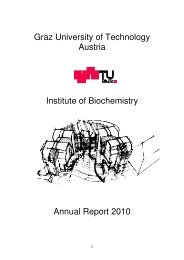Staff Members of the Institute of Biochemistry, TU - Institut für ...
Staff Members of the Institute of Biochemistry, TU - Institut für ...
Staff Members of the Institute of Biochemistry, TU - Institut für ...
You also want an ePaper? Increase the reach of your titles
YUMPU automatically turns print PDFs into web optimized ePapers that Google loves.
incomplete and did not provide <strong>the</strong> complete picture <strong>of</strong> <strong>the</strong> yeast lipid particle proteome. For<br />
this reason, a more precise lipid particle proteome analysis was initiated in collaboration with<br />
M. Karas from <strong>the</strong> <strong><strong>Institut</strong>e</strong> <strong>of</strong> Pharmaceutical Chemistry, Johann Wolfgang Goe<strong>the</strong><br />
University, Frankfurt, Germany. This proteome study was combined with a lipidomics<br />
investigation that was performed in collaboration with H. Köfeler from <strong>the</strong> Center for Medical<br />
Research, Medical University <strong>of</strong> Graz, Austria. In this study, we compared lipid particle<br />
components from cells which were grown on glucose or on oleic acid. This approach<br />
identified a number <strong>of</strong> lipid particle proteins that were already known but also some novel<br />
polypeptide candidates. Detailed investigations <strong>of</strong> <strong>the</strong>se proteins are currently in progress. We<br />
also realized through this approach that <strong>the</strong>re were some differences in <strong>the</strong> lipid particle<br />
proteome from cells grown on glucose or oleic acid. Finally, mass spectrometric analyses<br />
revealed marked differences in <strong>the</strong> lipidome <strong>of</strong> lipid particles from cells grown on <strong>the</strong> two<br />
different carbon sources. This study sets <strong>the</strong> stage for fur<strong>the</strong>r investigation <strong>of</strong> protein-lipid<br />
interaction on <strong>the</strong> surface <strong>of</strong> lipid particles and provides basic evidence for <strong>the</strong> coordinated<br />
biosyn<strong>the</strong>sis <strong>of</strong> lipid and protein components from lipid particles.<br />
Ano<strong>the</strong>r important aspect <strong>of</strong> this study was <strong>the</strong> physiological relevance <strong>of</strong> TAG and STE<br />
depot formation. Therefore, attempts were made to understand cell biological consequences <strong>of</strong><br />
dysfunctions in neutral lipid storage. Previously, it has been reported that yeast cells lacking<br />
neutral lipid depots appear to become apoptotic. More recently, we and o<strong>the</strong>rs were able to<br />
demonstrate that lipid depot formation plays an important role especially when yeast cells are<br />
stressed in <strong>the</strong> presence <strong>of</strong> exogenous fatty acids. However, it appears that an adaptation to<br />
this stress situation occurs which helps to overcome <strong>the</strong> deleterious effect <strong>of</strong> this lipotoxic<br />
stress. Changes in <strong>the</strong> lipid pattern caused by cultivation <strong>of</strong> yeast cells on oleic acid are<br />
currently investigated in some detail.<br />
In a previous study we had observed that variation <strong>of</strong> <strong>the</strong> yeast lipid particle composition by<br />
deletion <strong>of</strong> ei<strong>the</strong>r TAG or STE syn<strong>the</strong>sizing enzymes led to changes in <strong>the</strong> protein pattern on<br />
<strong>the</strong> lipid particle surface. In particular we realized that Erg1p, which is present at large<br />
amounts on lipid particles <strong>of</strong> wild type cells, loses stability in strains missing STE. During an<br />
ongoing project we performed stability and topology studies with different variants and<br />
constructs <strong>of</strong> Erg1p to elucidate embedding <strong>of</strong> this protein in <strong>the</strong> lipid particle surface<br />
membrane. This problem is related to <strong>the</strong> general question how lipid particle proteins are<br />
anchored in <strong>the</strong> monolayer membrane <strong>of</strong> <strong>the</strong> particle and/or interact with <strong>the</strong> hydrophobic core<br />
<strong>of</strong> <strong>the</strong> compartment. Although <strong>the</strong> evidence obtained so far is only preliminary we believe that<br />
<strong>the</strong> lipid status <strong>of</strong> lipid particles has a direct influence on <strong>the</strong> protein equipment <strong>of</strong> this<br />
compartment. This link may be related to <strong>the</strong> biogenesis <strong>of</strong> lipid particles.<br />
Ano<strong>the</strong>r potential non-polar storage lipid is squalene. This component belongs to <strong>the</strong> group <strong>of</strong><br />
isoprenoids and is precursor for <strong>the</strong> syn<strong>the</strong>sis <strong>of</strong> sterols, steroids and ubiquinons. In <strong>the</strong> yeast,<br />
<strong>the</strong> amount <strong>of</strong> squalene can be increased by varying culture conditions or by genetic<br />
manipulation. As an example, in strains deleted <strong>of</strong> HEM1 squalene accumulates and is stored<br />
mainly in lipid particles. Interestingly, a heme deficient dga1∆lro1∆are1∆are2∆ quadruple<br />
mutant (Qhem1∆) which is devoid <strong>of</strong> <strong>the</strong> classical storage lipids, TAG and SE, accumulates<br />
substantial amounts <strong>of</strong> squalene in cellular membranes, especially in microsomes and <strong>the</strong><br />
plasma membrane. The fact that Qhem1∆ does not form lipid particles suggests that<br />
biogenesis <strong>of</strong> <strong>the</strong>se storage particles cannot be initiated by squalene which is syn<strong>the</strong>sized in<br />
<strong>the</strong> ER similar to TAG and SE. This result also indicates that squalene accumulation, at least<br />
under <strong>the</strong> conditions tested, is not lipotoxic. Finally, our experiments demonstrate that<br />
squalene incorporated into organelle membranes does not compromise cellular function.<br />
19














